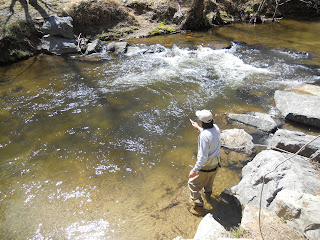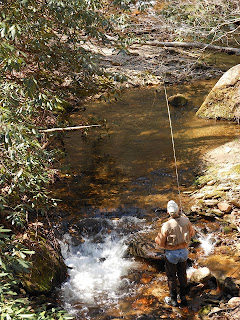 It's obvious to everyone that winter is here. Its even been rather cold here in southern Appalachia. With that being said, I thought I would share some tips on dressing and preparing your wader bag. Now I may be insulting the intelligence of some of you. However, having worked in the outdoor industry for several years has taught me that there are still plenty of people who don't know.
It's obvious to everyone that winter is here. Its even been rather cold here in southern Appalachia. With that being said, I thought I would share some tips on dressing and preparing your wader bag. Now I may be insulting the intelligence of some of you. However, having worked in the outdoor industry for several years has taught me that there are still plenty of people who don't know.Lets start with layering. Some of you may have switched to neoprene waders by now and that is a good idea. However, if you are like me and prefer breathable waders you have to insulate them some how. I see a lot of guys who simply pull their waders over their jeans, but when its below freezing, you should consider a pair of fleece wader pants. Not only are they way more comfortable, but they are a much better insulator. If you pair these up with a nice pair of mid calf wool socks and you're good to go. I know everyone is a little different but I have fished in eleven degree weather with ice floating by with this setup.

Now for the top half. It's the general rule to start with a base layer of a synthetic material which will dry faster if it gets wet. I tend to ignore this rule and wear a t-shirt instead. The next layer is what I consider the warming layer. I prefer a nice thin fleece shirt as you will see me wearing in many of my fishing photos. I follow this with one of two outer shells if need be. On colder days in which there is little to no chance of rain I prefer a windproof fleece jacket. For those rainy days there is one item that no fly fisherman should be without, the wader jacket. The nice thing about layering is that you can wear any combination of these items to suit your needs. You can accessorize as you see fit with a beanie and or wool gloves.
The wader bag.
 When its this cold out it is a good idea to toss a few extra items into your wader bag as well. If you accidentally take a dip your going to be in real danger of hypothermia which could ruin your day of fishing. For that reason you should have extra change of of clothes starting with another pair of socks. If you happen to have a second pair of wader pants you should pack them as well. If not you can bring that pair of sweat pants that probably have the name of your favorite football team down the leg. Its not about looking cool if you have to change into them, its about getting warm. Don't forget another top. Perhaps the matching sweatshirt. Its also nice to have a warm lunch while on the water. That is why I like to toss one of my trusty old jet boils in the mix. Not only can you cook some Ramen, but if you need it you can make a hot cup of spiced cider in just under two minutes.
When its this cold out it is a good idea to toss a few extra items into your wader bag as well. If you accidentally take a dip your going to be in real danger of hypothermia which could ruin your day of fishing. For that reason you should have extra change of of clothes starting with another pair of socks. If you happen to have a second pair of wader pants you should pack them as well. If not you can bring that pair of sweat pants that probably have the name of your favorite football team down the leg. Its not about looking cool if you have to change into them, its about getting warm. Don't forget another top. Perhaps the matching sweatshirt. Its also nice to have a warm lunch while on the water. That is why I like to toss one of my trusty old jet boils in the mix. Not only can you cook some Ramen, but if you need it you can make a hot cup of spiced cider in just under two minutes. I know this may be redundant, but I hope that at least a few of you get something out of it. If anything, you might remember to pack that second pair of socks.
See you on the trail,
Lance










































